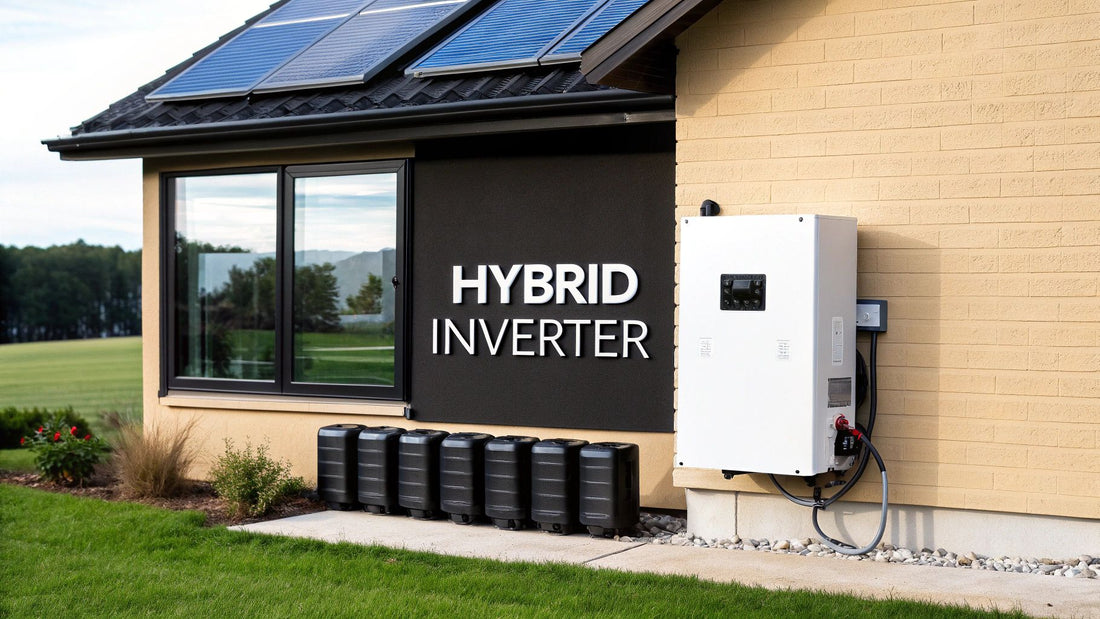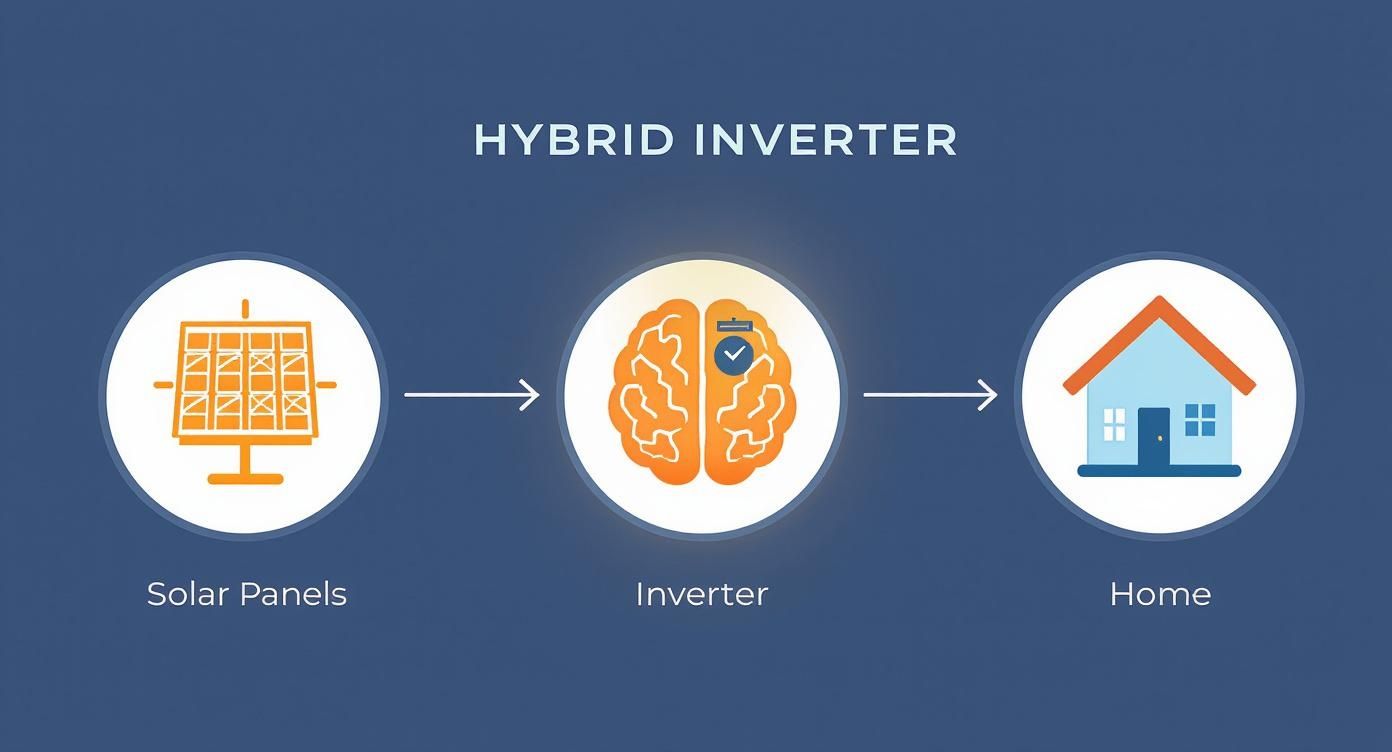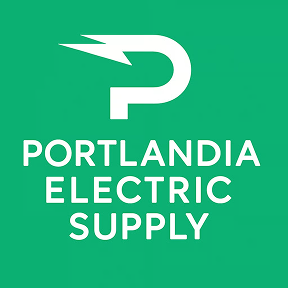
What Is a Hybrid Inverter? A Guide for Installers, Developers & Homeowners
Share
A hybrid inverter is the operational brain of a modern solar-plus-storage system. For installers, developers, and homeowners, it’s the critical all-in-one device that manages power flow between solar panels, batteries, and the grid, combining the functions of a standard solar inverter and a battery inverter into one smart, future-proof package. Understanding its role is key to designing resilient, cost-effective energy systems that meet today's project demands and compliance standards.
This guide provides actionable insights for specifying, installing, and leveraging hybrid inverters. Whether you're a homeowner seeking energy independence, an installer navigating NEC and UL compliance, or a developer optimizing project ROI, you'll find the practical details needed to make informed decisions.
Unpacking the Role of a Hybrid Inverter
Think of a hybrid inverter as an intelligent energy traffic controller. Its primary function is converting DC power from solar panels into usable AC power for a building. But its real value lies in its dynamic decision-making capability.
The inverter constantly assesses system status: Is the sun producing power? Is the battery charged? Is the grid stable? What are the building's immediate load requirements? Based on the answers, it routes electricity in real-time to maximize self-consumption, provide backup power, and minimize grid dependency, making it a cornerstone of any modern energy project.
For Installers & Developers: The key differentiator of a hybrid inverter is its flexibility. It allows for a phased project approach—installing a solar array now and seamlessly adding a battery bank later without replacing core hardware. This future-proofs the investment and provides a clear upgrade path for clients, a significant advantage in quoting scenarios.
Core Functions of a Hybrid Inverter
A single hybrid inverter juggles multiple critical tasks, offering a level of control and integration that legacy multi-component systems cannot match. Familiarity with these functions is essential for anyone designing or purchasing a solar energy system. You can see how far the technology has come by comparing different solar inverter types.
A breakdown of its primary jobs:
- Power Loads Directly: During peak sun hours, it prioritizes sending solar-generated power straight to the building’s circuits to offset immediate grid consumption.
- Charge Batteries: Once building loads are met, it directs excess solar energy to charge the battery bank, storing it for use during non-production hours or outages.
- Export to the Grid: If the building's needs are met and the batteries are fully charged, it can export surplus power back to the utility grid, often generating bill credits under net metering agreements.
- Provide Backup Power: In the event of a grid failure, it instantly disconnects from the utility (islanding) and draws power from the batteries to keep essential circuits operational.
Comparing Solar Inverter Functions
This table highlights the hybrid inverter's superior capabilities compared to older inverter types, making it the default choice for modern, resilient energy systems.
| Function | Grid-Tied Inverter | Off-Grid Inverter | Hybrid Inverter |
|---|---|---|---|
| Convert Solar DC to AC | ✔️ | ✔️ | ✔️ |
| Manage Battery Charging | ❌ | ✔️ | ✔️ |
| Export Power to Grid | ✔️ | ❌ | ✔️ |
| Provide Grid-Down Backup | ❌ | ✔️ | ✔️ |
| Grid & Battery Power Blend | ❌ | ❌ | ✔️ |
The hybrid model combines the grid-connectivity of a grid-tied system with the energy independence and backup resilience of an off-grid setup, all in one UL-certified package.
How Your Hybrid Inverter Manages Power Day and Night
A hybrid inverter is a smart energy manager that constantly optimizes your system for economic and resilience benefits. Its operational logic is designed to maximize the use of self-generated solar power, a key reason the global hybrid inverter market is projected to grow from USD 3.99 billion in 2025 to USD 9.56 billion by 2031. This growth is driven by demand for greater self-consumption and reliable backup power.
This flow chart visualizes how the inverter serves as the central command hub for the entire solar energy system, prioritizing on-site loads before storing or exporting energy.

The system is designed so that no generated energy is wasted; it is either used immediately, stored for later, or exported for credit.
A Sunny Afternoon Scenario
During a typical sunny day, the solar panels are at peak production. The hybrid inverter directs this power to run the building's active loads—HVAC systems, lighting, and equipment. Any surplus energy beyond what the building consumes is used to charge the battery bank. If the batteries are full and there is still excess solar production, the inverter exports the power to the utility grid, optimizing the system's financial return.
When the Grid Goes Down
This is the most critical function of a hybrid inverter. The moment it detects a grid outage, it performs two actions nearly simultaneously: it safely disconnects from the grid to prevent back-feeding (a safety requirement known as anti-islanding) and switches the power source to the battery bank to run the designated backup loads. This transition is typically seamless, ensuring that critical circuits remain powered without interruption. This functionality is the core of any modern energy storage system.
Evening Energy Use
After sunset, solar production ceases. Instead of immediately drawing expensive power from the grid, the inverter transitions to drawing from the energy stored in the batteries earlier in the day. This strategy, known as "self-consumption," powers the home or business through the evening and overnight, significantly reducing reliance on the utility and lowering electricity bills, especially in areas with time-of-use (TOU) rates.
Building Your Complete Hybrid Solar System
A hybrid inverter is the control center, but it requires several key components to form a complete, code-compliant energy system. Understanding how these parts integrate is crucial for system design and installation.
It begins with the solar panel array, which captures sunlight and produces DC electricity. This raw power is fed directly to the hybrid inverter for conversion and management.
Key System Components
A complete hybrid setup is an integrated system where each component has a defined role, orchestrated by the inverter.
- Solar Panel Array: The system's power generator. The array's size (kW) determines the maximum power production capacity.
- Battery Bank: The energy reservoir. The inverter manages charging from surplus solar and discharging to power loads. Battery compatibility is critical; systems are typically designed around proven, certified pairings from brands like FranklinWH or BYD.
-
Main Electrical Panel (Breaker Box): The central distribution point for the building's electricity. The hybrid inverter connects here to power circuits and, for grid-tied systems, to export excess energy back to the utility.
Critical Mistake to Avoid for Installers: Failure to ensure all connections adhere to the latest National Electrical Code (NEC) and use UL-certified equipment is a major liability. A clean, code-compliant integration at the main panel is essential for safety functions like rapid shutdown, proper overcurrent protection, and grid interconnection approval.
When these components are specified correctly on a bill of materials (BOM), you have a functional, resilient power station. The inverter is the component that enables all the hardware to communicate and work in unison.
For a deeper technical dive, review our guide on how to hook up solar panels to batteries.
What This Means in the Real World
Beyond technical specifications, a hybrid inverter system delivers tangible value by providing energy control, cost savings, and resilience. It allows users to actively manage their energy consumption and reduce dependence on fluctuating utility rates and an unreliable grid.
The market is responding to this value proposition. Analysts project the hybrid inverter market will grow from USD 3.58 billion in 2025 to USD 7.72 billion by 2032. This expansion is driven by features that empower end-users to control their energy consumption directly. You can discover more insights about this market growth on coherentmi.com.
How It Pays Off for Different Users
The benefits of a hybrid system vary depending on the use case and priorities of the end-user.
- For Homeowners: The primary benefits are lower utility bills and energy security. The system can be programmed to use stored battery power during expensive peak rate periods, and it provides automatic backup power during outages. A fully integrated solar-plus-storage system is also a significant differentiator that can increase property value.
- For Commercial Users: The focus is on operational cost reduction and business continuity. Stored energy can be used to avoid high "demand charges" from the utility, a practice known as peak shaving, which can save thousands annually. It also ensures critical business operations continue during grid failures and helps meet corporate sustainability goals.
Understanding the advantages of solar energy over traditional power sources clarifies the immense value of this technology. A hybrid inverter system is a practical investment in a more secure and cost-effective energy future.
How to Choose the Right Hybrid Inverter
Selecting the right hybrid inverter is the most critical decision in a solar-plus-storage project. This single piece of equipment determines backup power capacity, battery efficiency, scalability, and the overall return on investment. The goal is to match the inverter's specifications to the project's specific energy goals and site constraints.
For residential applications, single-phase inverters are typical. For commercial projects, three-phase models are standard to handle larger electrical loads efficiently. This distinction is significant in the market; three-phase units currently account for over 61% of the $10.71 billion global solar hybrid inverter market. With the market projected to reach $17.24 billion by 2030, making a well-informed choice is essential. You can read the full research about these market trends here.
Key Decision-Making Factors
It is essential to look past marketing claims from brands like Sungrow, Fronius, or Sol-Ark and focus on the core technical specifications.
Here are the critical factors for your checklist:
- System Sizing (kW Rating): The inverter's continuous and peak power ratings must be sufficient to handle the total load of the circuits it will power, especially during a grid outage. An undersized inverter will lead to nuisance tripping, while an oversized one is an unnecessary capital expense.
- Battery Compatibility: This is non-negotiable. Verify that the inverter is officially listed and certified to work with the chosen battery's voltage (e.g., 48V for most residential systems) and chemistry (e.g., Lithium Iron Phosphate - LFP). Mismatched components can void warranties and create safety hazards.
- Warranty and Support: A quality hybrid inverter should have a minimum 10-12 year warranty. Equally important is the availability of U.S.-based technical support. When an installer encounters a commissioning issue on a job site, access to expert support is critical to avoid costly project delays.
Compliance Watchout for Installers: Never procure an inverter without first confirming it meets all local utility interconnection requirements and national standards, particularly UL 1741 SB. Verifying compliance upfront prevents major roadblocks during the permitting and inspection process, ensuring a safe and legally operable system for the client.
Hybrid Inverter Selection Checklist
Use this checklist to align project requirements with inverter specifications for both residential and commercial applications.
| Specification | Residential Consideration | Commercial Consideration |
|---|---|---|
| AC Power Output (kW) | Must cover peak household loads (AC, appliances). Typically 8kW to 15kW. | Needs to support critical business loads and machinery. Often 30kW+. |
| PV Input (MPPTs) | 2-4 MPPTs are usually sufficient for a simple roof with a few orientations. | Multiple MPPTs are essential to manage large, complex arrays across different roof sections. |
| Battery Voltage | 48V is the most common standard for home energy storage systems. | Higher voltage systems (HV) are common for efficiency and smaller wire gauges. |
| Grid Interaction | Needs to support grid-tied, hybrid, and off-grid modes for backup power. | Advanced grid support functions (VPP, frequency response) may be required. |
| Scalability | Look for models that allow for easy parallel stacking to add more power later. | Essential. The system must be able to scale as the facility's energy needs grow. |
| Monitoring Platform | User-friendly app for homeowners to track energy production and consumption. | Robust enterprise-level software with detailed analytics and remote control. |
| Certifications | UL 1741 SB and compliance with local utility rules are non-negotiable. | Must meet all national and local commercial electrical and safety codes. |
This structured approach ensures you select hardware that is precisely suited for the job, avoiding costly over-specification or performance-limiting under-specification.
Planning Your Hybrid System Installation
With a clear understanding of what a hybrid inverter is and how it functions, the next step is implementation. Whether you are a homeowner pursuing energy independence or an installer planning your next project, access to reliable equipment and expert support is crucial for a successful outcome.
For Homeowners
Navigating the process of a solar-plus-storage installation can be complex. We provide tools to simplify your journey and ensure you connect with qualified professionals.
- Estimate Your Savings: Use our Submit My Bill tool for a personalized analysis of your potential savings.
- Find a Trusted Professional: Our PowerLink service can connect you with a vetted local installer to ensure a high-quality installation.
For Installers & Developers
In a competitive market, project efficiency is paramount. Supply chain delays and equipment availability can derail timelines and budgets.
We maintain a deep inventory of top-tier brands like Sungrow and FranklinWH, backed by nationwide logistics to ensure equipment arrives at your job site on time. Our team of system design experts is available to assist with equipment selection, system design, and volume pricing to keep your projects on schedule and profitable.
Pro Tip for Procurement: Don't let supply chain bottlenecks disrupt your project pipeline. We offer real-time inventory visibility and optimized freight solutions to get you the equipment you need, when you need it. Request a Bulk Quote to secure pricing and lead times for your next project.
Still Have Questions? We Have Answers.
Here are answers to some of the most common technical and practical questions about hybrid inverters from both homeowners and industry professionals.
Can a Hybrid Inverter Work Without Batteries?
Yes, absolutely. A key design feature of a modern hybrid inverter is its modularity. It can be installed with only solar panels and function as a standard grid-tied inverter, delivering immediate savings on electricity bills. This allows homeowners to invest in solar now and add energy storage later without replacing the core inverter hardware, providing a clear and cost-effective upgrade path.
What's the Difference Between a Hybrid and an Off-Grid Inverter?
The fundamental difference is the ability to interact with the utility grid. A hybrid inverter is designed to work in conjunction with the grid, intelligently blending power from solar, batteries, and the utility. This provides both energy savings and reliable backup power. An off-grid inverter is designed for complete grid independence and cannot legally or safely connect to the utility. For virtually all residential and commercial properties in serviced areas, the flexibility and resilience of a hybrid system is the superior choice.
How Long Does a Hybrid Inverter Last?
A reputable hybrid inverter is a durable piece of industrial electronics engineered for a long service life. Top-tier manufacturers typically provide a 10 to 12-year warranty. However, with proper professional installation and adequate ventilation, these units are designed to operate reliably for 15 years or more. It is always best practice for installers and buyers to review the specific warranty documentation for any model under consideration to understand coverage terms.
Ready to design a resilient and efficient solar-plus-storage system? The experts at Portlandia Electric Supply can help you select the right hybrid inverter and components for your project, backed by in-stock inventory and nationwide logistics.
